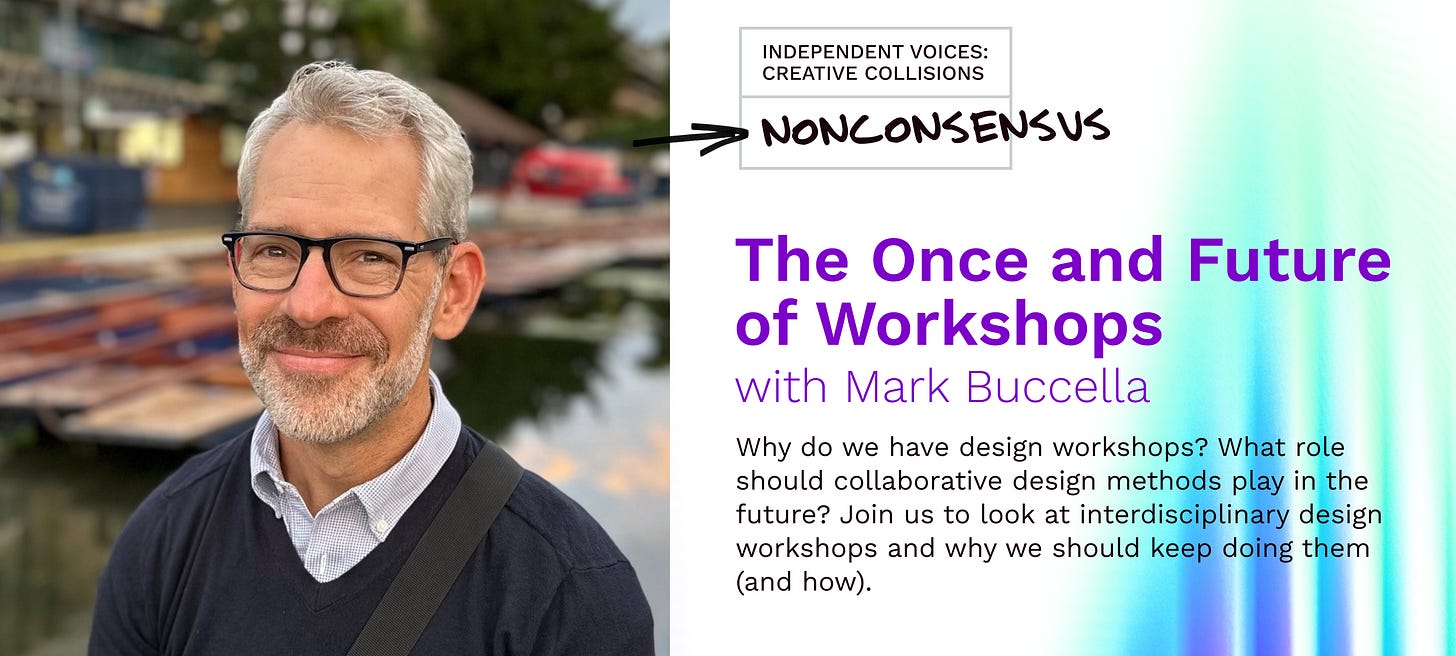This week’s post is by Mark Buccella. Mark is a strategic problem solver, design thinker, facilitation trainer, and player/coach. If your team wants to level up their skills to tackle the hard things, connect with Mark on LinkedIn.

Collaboration. Co-design. Co-creation. Sketching studio. Exploration. Design sprint. Iteration zero. Workshop. We've called them many things in the 15+ years I’ve been facilitating. Usually, I try not to waste time finding the right label. Better to gather the team, align on the approach, and dig in. However, recent opportunities I’ve had to train people in collaborative design facilitation have prompted me to answer some common questions. What makes a collaboration workshop session productive? How have they changed? What might they look like in the future?
I’m still not terribly interested in finding the perfect label. They all have their benefits depending on context, where you are in the process, and who’s invited to participate. But lately, I’ve been gravitating to one label more than others:
work·shop /ˈwərkˌSHäp/ noun
a room or building in which goods are manufactured or repaired.
Similar: factory, works, plant, shop, garage, workroom, studio, ateliera meeting at which a group of people engage in intensive discussion and activity on a particular subject or project.
Similar: study group, discussion group, seminar, class, verb
As human-centered design began to emerge in the mid-20th century, engineers started combining the idea of a workshop as a physical place to build and tinker with a process for collaborative problem-solving. What I like about “workshop” is it vividly captures the image of a team rapidly prototyping and testing their ideas. But in recent years, it’s become more difficult for workshops to maintain that feeling of scrappy real-world collaboration.
When Workshops (and all Work) Changed
In the spring of 2020, workshops went entirely online, just like everything else. Goodbye whiteboards, Post-Its, and Sharpies, hello Miro and Zoom. I’ve led dozens of online design workshops in the last four years. And like many pandemic-era changes, some have been positive, some less so. Miro and similar tools have not only been indispensable for online collaboration, but in many ways, they are a huge improvement. Digital whiteboards and sticky notes are always accessible wherever and whenever you are, eliminating the need to take photos or rollup easel board sheets to reference later. And teams can return to them repeatedly, export them, share them with other stakeholders, continue to iterate, and so on.
Online workshops are also more accessible for people new to the process. A Miro board and a Zoom session have a training wheels effect. They’re less intimidating than a conference room at a client’s office (it’s hard to get too nervous when you’re still in your pj pants). And the methods can be scaffolded in advance to make them easier to follow. For me, one of the biggest upsides of the pandemic was having more opportunities to introduce dozens of people to design thinking methods.
However, the drawbacks to online workshops are significant. Because Zoom can be so fatiguing, it isn’t practical to ask a group to collaborate intensely for 5+ hours a day for two or more days as we might in person. Multiple 2-3 hour chunks over several days are more doable. But that compromise comes with a loss of energy and momentum, dulling the impact, immediacy, and alchemy of in-person collaboration.
And digital collaboration tools can create a false sense of accomplishment. It’s easy for a team to feel like they’ve done something after they’ve been shuffling sticky notes for an hour. They’re also inherently high-fidelity, with their infinite whiteboard space and sticky notes in which you can write a novella. This can be a hurdle for teams creating lower-fidelity prototypes or designing stimuli for rapid early feedback.
This can all add up to a loss of rigor and a watering-down of the impact of workshops. And in the post-pandemic years, I’ve seen a check-the-box way of thinking creeping in. “The team did the thing in Miro; we’re ready to move on.”
Workshops of the Future
Remote or hybrid workshops aren’t going away. As virtual and augmented reality play more of a role in the day-to-day work of dispersed teams, we can count on more change to come. However, the mechanics of collaboration shouldn’t impede the benefits of workshops. It’s a poor facilitator who blames their tools.
So fast forward five years. You’re ‘with’ your new client in their VR meeting space, discussing the design workshop you will have with their team spread across ten time zones. You’ll use a mix of in-person, virtual-, and augmented-reality meeting modes and collaborate with AI participants. What’s your plan?
Be mindful of the design thinking stages and where you are in the process. Are you seeking to gain empathy? Redefine the problem based on your insights? Ideate on potential solutions? Test a prototype? Some combination? Don’t let the context get in the way of keeping that focus. Design your agenda and methods to drive to that outcome.
Time and attention will continue to be the most precious resources for design workshops. Make the best use of the diverse perspectives you’ve gathered. Ensure active participation in advance by clarifying why they’re needed and setting clear expectations for their role.
Show, don’t tell; try to keep it analog where you can. Especially for early ideation and prototyping, reduce the temptation to rely on high-fidelity digital tools. I’m a big proponent of sketching and storyboarding. Regardless of where people are, make sure they have paper and Sharpies and have them use their phones to post their sketches.
Make use of downtime. Even if the design thinking phases need to get spread out over a more extended period to reduce Zoom fatigue, take advantage of the time between live sessions for smaller groups to do more research, analyze ideas, or build a quick, low-fi prototype before the next session.
Use an online workshop to your advantage and recruit end users to join you for testing. It’s easier to get people to pop into an online session than to ask them to travel to your physical space to see your prototypes. Push your team to make something they can get feedback on and get real people to join you.
If you’re interested in creating productive, collaborative workshops, join me on September 27th for a deep dive into workshops at the Independent Voices : Creative Collisions virtual summit!
I’ll be speaking on The Once and Future of Workshops: Why interdisciplinary collaborative design is relevant in a post-pandemic, AI-emergent world. Learn more and register: https://www.northomegroup.com/independent-voices-creative-collisions-fall-2024/
Mark is a strategic problem solver, design thinker, and human-centered design expert. He works as a researcher, strategist, and trainer, applying design thinking methods to help teams discover insights about customer needs, identify opportunities for innovation, and ideate on potential solutions.
If your team wants to level up their skills to tackle the hard things, connect with Mark on LinkedIn.
He has worked for companies such as Honeywell, United Healthcare, National Grid, Oracle, General Mills, Thrivent, E*TRADE, Room & Board, American Public Media, The McKnight Foundation, The University of Minnesota, and the State of Minnesota.



